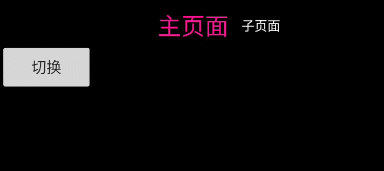Android 代码动态修改RelativeLayout布局
前言
有时我们会遇到在xml布局文件中设置好界面后,但是又需要从代码中进行动态布局修改。
之前从网上寻找了好多资料,看到的都是新建一个布局文件
但是我的需求又是从当前布局文件的基础上进行修改。
下面用一个示例大家介绍一个比较简单的办法。
演示
该例子主要是使用RelativeLayout布局,放置两个TextView,点击切换按钮进行切换,永远有一个TextView保持屏幕中间。

activity_main.xml
<?xml version="1.0" encoding="utf-8"?>
<LinearLayout xmlns:android="http://schemas.android.com/apk/res/android"
xmlns:tools="http://schemas.android.com/tools"
android:layout_width="match_parent"
android:layout_height="match_parent"
android:background="@android:color/background_dark"
android:orientation="vertical"
tools:context=".MainActivity">
<RelativeLayout
android:id="@+id/relativeLayout"
android:layout_width="match_parent"
android:layout_height="wrap_content">
<TextView
android:id="@+id/text_small"
android:layout_width="wrap_content"
android:layout_height="wrap_content"
android:layout_centerHorizontal="true"
android:layout_centerVertical="true"
android:layout_marginEnd="6dp"
android:text="主页面"
android:textColor="@color/deeppink"
android:textSize="22sp" />
<TextView
android:id="@+id/text_big"
android:layout_width="wrap_content"
android:layout_height="wrap_content"
android:layout_centerVertical="true"
android:layout_marginStart="6dp"
android:layout_toEndOf="@id/text_small"
android:text="子页面"
android:textColor="@color/white"
android:textSize="12sp" />
</RelativeLayout>
<Button
android:id="@+id/btn"
android:layout_width="wrap_content"
android:layout_height="wrap_content"
android:text="切换" />
</LinearLayout>
MainActivity.java
public class MainActivity extends AppCompatActivity {
// TextView
private TextView text_small;
private TextView text_big;
// 布局参数
private RelativeLayout.LayoutParams params_small;
private RelativeLayout.LayoutParams params_big;
// 切换按钮
private Button btn;
// 切换标识
private boolean check = false;
@Override
protected void onCreate(Bundle savedInstanceState) {
super.onCreate(savedInstanceState);
setContentView(R.layout.activity_main);
text_small = findViewById(R.id.text_small);
text_big = findViewById(R.id.text_big);
btn = findViewById(R.id.btn);
// 获取TextView的布局参数
params_small = (RelativeLayout.LayoutParams) text_small.getLayoutParams();
params_big = (RelativeLayout.LayoutParams) text_big.getLayoutParams();
// 按钮切换
btn.setOnClickListener(new View.OnClickListener() {
@Override
public void onClick(View v) {
if (check) {
// 切换子页面
smallModeSwitch();
check = false;
} else {
// 切换主页面
bigModeSwitch();
check = true;
}
}
});
}
/**
* 修改布局
*
* @date: 2021/1/28 16:07
* @author: SiYuan Jiao
*/
private void bigModeSwitch() {
// 设置字体及颜色
text_big.setTextSize(22);
text_big.setTextColor(Color.parseColor("#ff1493"));
text_small.setTextSize(12);
text_small.setTextColor(Color.WHITE);
// 删除主页面居中效果
params_small.removeRule(RelativeLayout.CENTER_HORIZONTAL);
// 添加主页面对于子页面的相对位置
params_small.addRule(RelativeLayout.START_OF, R.id.text_big);
// 设置主页面应用此效果
text_small.setLayoutParams(params_small);
// 添加子页面居中效果
params_big.addRule(RelativeLayout.CENTER_HORIZONTAL);
// 删除原有相对主页面的位置
params_big.removeRule(RelativeLayout.END_OF);
// 子页面应用此效果
text_big.setLayoutParams(params_big);
}
private void smallModeSwitch() {
text_small.setTextSize(22);
text_small.setTextColor(Color.parseColor("#ff1493"));
text_big.setTextSize(12);
text_big.setTextColor(Color.WHITE);
params_big.removeRule(RelativeLayout.CENTER_HORIZONTAL);
params_big.addRule(RelativeLayout.END_OF, R.id.text_small);
text_big.setLayoutParams(params_big);
params_small.addRule(RelativeLayout.CENTER_HORIZONTAL);
params_small.removeRule(RelativeLayout.START_OF);
text_small.setLayoutParams(params_small);
}
}
结束
其中主要是通过getLayoutParams()方法获取当前布局信息,使用removeRule()删除不要的属性,使用addRule()添加需要的属性值,最后使用setLayoutParams进行应用配置。
通过以上的例子,应该能解决动态代码修改RelativeLayout布局的问题。
感谢
如果对你有用,请点个爱心给个赞吧~~























 6659
6659











 被折叠的 条评论
为什么被折叠?
被折叠的 条评论
为什么被折叠?










